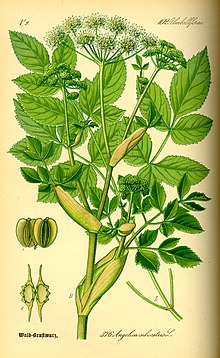
Back حشيشة الملاك Arabic حشيشة الملاك ARZ Tütəkcə Azerbaijani Шыма көпшә Bashkir Дуднік Byelorussian Ангелика Bulgarian Angelica (gènere) Catalan Angelica (tanom nga kinsay) CEB Llysiau'r angel Welsh Angelik (slægt) Danish
| Angelica | |
|---|---|

| |
| Wild angelica (Angelica sylvestris) | |
| Scientific classification | |
| Kingdom: | Plantae |
| Clade: | Tracheophytes |
| Clade: | Angiosperms |
| Clade: | Eudicots |
| Clade: | Asterids |
| Order: | Apiales |
| Family: | Apiaceae |
| Subfamily: | Apioideae |
| Tribe: | Selineae |
| Genus: | Angelica L. |
| Species | |
|
About 90 species; see text. | |
| Synonyms[1] | |
| |

Angelica is a genus of about 90 species of tall biennial and perennial herbs in the family Apiaceae, native to temperate and subarctic regions of the Northern Hemisphere, reaching as far north as Iceland, Lapland, and Greenland.[2] They grow to 1–3 m (3 ft 3 in – 9 ft 10 in) tall, with large bipinnate leaves and large compound umbels of white or greenish-white flowers. Found mainly in China, its main use was for medicine. It shows variations in fruit anatomy, leaf morphology, and subterranean structures. The genes are extremely polymorphic.
Some species can be found in purple moor and rush pastures.

- ^ Cite error: The named reference
POWOwas invoked but never defined (see the help page). - ^ Johannes Gröntved. "Kvanen -. Dens Udbredelse Og Anvendelse" (PDF).